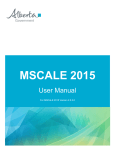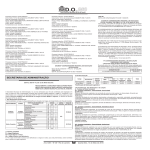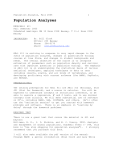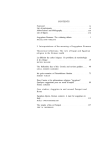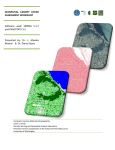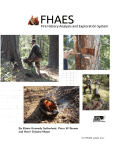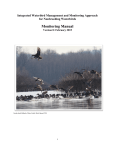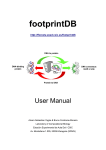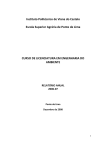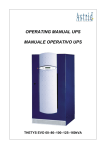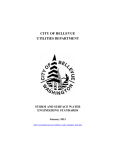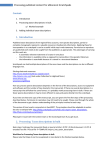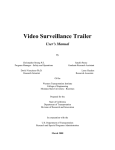Download Fire Ecology Manuscript Format Guidelines and Submission
Transcript
Fire Ecology Guidelines
(Adapted from Chamberlain, M.J., and Johnson, C. 2007. Journal
of Wildlife Management guidelines. The Wildlife Society,
Washington, D.C., USA.)
Edited by Jan W. van Wagtendonk
Association for Fire Ecology
Revised Spring 2015 by
James K. Agee, Editor
Laurie L. Burk, Technical Editor
Fire Ecology Guidelines
Spring 2015
i
Table of Contents
I. SUBMISSION REQUIREMENTS . . . . . . . . . . . . . . . . . . . . . . . . . . . . . . . . 1
A. General Format Guidelines . . . . . . . . . . . . . . . . . . . . . . . . . . . . . . . . . . 1
B. General Guidelines . . . . . . . . . . . . . . . . . . . . . . . . . . . . . . . . . . . . . . . . . 1
II. ARTICLE FORMAT AND CRITERIA . . . . . . . . . . . . . . . . . . . . . . . . . . . . 2
A. Headings Formats . . . . . . . . . . . . . . . . . . . . . . . . . . . . . . . . . . . . . . . . . 2
1. Running Header . . . . . . . . . . . . . . . . . . . . . . . . . . . . . . . . . . . . . . . 2
2. First-level Heading . . . . . . . . . . . . . . . . . . . . . . . . . . . . . . . . . . . . . 2
3. Second-level Heading . . . . . . . . . . . . . . . . . . . . . . . . . . . . . . . . . . 2
4. Third-level Heading . . . . . . . . . . . . . . . . . . . . . . . . . . . . . . . . . . . . 2
B. Title Page Format . . . . . . . . . . . . . . . . . . . . . . . . . . . . . . . . . . . . . . . . . . 3
1. Title . . . . . . . . . . . . . . . . . . . . . . . . . . . . . . . . . . . . . . . . . . . . . . . . 3
2. Authors and Affiliations . . . . . . . . . . . . . . . . . . . . . . . . . . . . . . . . . 3
3. Corresponding Author . . . . . . . . . . . . . . . . . . . . . . . . . . . . . . . . . . 3
4. Abstract . . . . . . . . . . . . . . . . . . . . . . . . . . . . . . . . . . . . . . . . . . . . . 3
5. Keywords . . . . . . . . . . . . . . . . . . . . . . . . . . . . . . . . . . . . . . . . . . . . 4
6. Citation . . . . . . . . . . . . . . . . . . . . . . . . . . . . . . . . . . . . . . . . . . . . . . 4
C. Major Sections of the Manuscript . . . . . . . . . . . . . . . . . . . . . . . . . . . . 4
1. Introduction . . . . . . . . . . . . . . . . . . . . . . . . . . . . . . . . . . . . . . . . . . 4
2. Methods . . . . . . . . . . . . . . . . . . . . . . . . . . . . . . . . . . . . . . . . . . . . . 4
3. Results . . . . . . . . . . . . . . . . . . . . . . . . . . . . . . . . . . . . . . . . . . . . . . 5
4. Discussion . . . . . . . . . . . . . . . . . . . . . . . . . . . . . . . . . . . . . . . . . . . 5
5. Acknowledgements . . . . . . . .. . . . . . . . . . . . . . . . . . . . . . . . . . . . . . 6
6. Literature Cited . . . . . . . . . . . . . . . . . . . . . . . . . . . . . . . . . . . . . . . 6
7. Figure Captions and Tables . . . . . . . . . . . . . . . . . . . . . . . . . . . . . . 6
III. STYLE AND USAGE . . . . . . . . . . . . . . . . . . . . . . . . . . . . . . . . . . . . . . . . . . 6
A. General Comments . . . . . . . . . . . . . . . . . . . . . . . . . . . . . . . . . . . . . . . . . 6
B. Elements of Style and Usage . . . . . . . . . . . . . . . . . . . . . . . . . . . . . . . . 6
1. Punctuation . . . . . . . . . . . . . . . . . . . . . . . . . . . . . . . . . . . . . . . . . . 6
Commas
Quotation Marks
Hyphenation
Fences
Slashes
2. Names . . . . . . . . . . . . . . . . . . . . . . . . . . . . . . . . . . . . . . . . . . . . . . 8
Product Names
Common and Scientific Names
Abbreviations and Acronyms
3. Enumerating Series of Items . . . . . . . . . . . . . . . . . . . . . . . . . . . . . 9
4. Numbers . . . . . . . . . . . . . . . . . . . . . . . . . . . . . . . . . . . . . . . . . . . . 9
General Rules
Time and Dates
Mathematics and Statistics
Equations
Measurement Units
5. Citing Literature in Text . . . . . . . . . . . . . . . . . . . . . . . . . . . . . . . . 12
Published Documents
Unpublished Sources
Equipment and Statistical Software
Fire Ecology Guidelines
Spring 2015
ii
IV.TABLES AND FIGURES . . . . . . . . . . . . . . . . . . . . . . . . . . . . . . . . . . . . . 14
A. General Rules . . . . . . . . . . . . . . . . . . . . . . . . . . . . . . . . . . . . . . . . . . . . 14
B. Tables . . . . . . . . . . . . . . . . . . . . . . . . . . . . . . . . . . . . . . . . . . . . . . . . . . 14
1. General Rules . . . . . . . . . . . . . . . . . . . . . . . . . . . . . . . . . . . . . . . 14
2. Table Titles . . . . . . . . . . . . . . . . . . . . . . . . . . . . . . . . . . . . . . . . . . 15
3. Table Column and Row Headings . . . . . . . . . . . . . . . . . . . . . . . . 15
4. Table Data Field . . . . . . . . . . . . . . . . . . . . . . . . . . . . . . . . . . . . . . 16
5. Table Footnotes . . . . . . . . . . . . . . . . . . . . . . . . . . . . . . . . . . . . . . 16
C. Figures: Photographs and Line Drawings . . . . . . . . . . . . . . . . . . . . . . . . 16
1. General Rules . . . . . . . . . . . . . . . . . . . . . . . . . . . . . . . . . . . . . . . 16
2. Photographs . . . . . . . . . . . . . . . . . . . . . . . . . . . . . . . . . . . . . . . . 17
3. Line Drawings . . . . . . . . . . . . . . . . . . . . . . . . . . . . . . . . . . . . . . . . 17
4. Figure Captions . . . . . . . . . . . . . . . . . . . . . . . . . . . . . . . . . . . . . . 18
V.LITERATURE CITED FORMATS . . . . . . . . . . . . . . . . . . . . . . . . . . . . . . 18
A. General Rules . . . . . . . . . . . . . . . . . . . . . . . . . . . . . . . . . . . . . . . . . . . 18
B. Examples of Specific Formats . . . . . . . . . . . . . . . . . . . . . . . . . . . . . . 19
1. Books . . . . . . . . . . . . . . . . . . . . . . . . . . . . . . . . . . . . . . . . . . 19
Book: More Than One Edition
Book: More Than One Publisher
Book: More Than One Volume
Book: Editor as Author
Book: Reprint
Book: Chapter
2. Journals . . . . . . . . . . . . . . . . . . . . . . . . . . . . . . . . . . . . . . . . . 20
Journals: General Format
Journals in Press: Year and Volume Known
Journals in Press: Year and Volume Unknown
Multiple Citations of the Same Author(s)
3. Proceedings . . . . . . . . . . . . . . . . . . . . . . . . . . . . . . . . . . . . . . . . 21
Proceedings: Complete Volume
Proceedings: Individual Article
Proceedings: Part of a Numbered Series
Proceedings: Complete Volume (not part of a numbered series)
Proceedings: Individual Article (not part of a numbered series)
4. Reports . . . . . . . . . . . . . . . . . . . . . . . . . . . . . . . . . . . . . . . . . . . 21
Report: Not Part of a Numbered Series
Report: Part of a Numbered Series
Report: Agency as Author
5. Other . . . . . . . . . . . . . . . . . . . . . . . . . . . . . . . . . . . . . . . . . . . . . 22
Court Cases
Foreign Language Publication
Newspaper, Newsletter, and Magazine Articles
Software Package
Theses or Dissertations
Web Citation: Professional Site
Web Citation: Government Publication
VI. APPENDIX. REQUIRED ABBREVIATIONS FOR TABLES,
FIGURES, AND PARENTHETIC EXPRESSIONS . . . . . . . . . . . . . . . . . 24
Fire Ecology Guidelines
Spring 2015
1
Fire Ecology Guidelines
Manuscripts must adhere to Fire Ecology guidelines before they will be approved and sent out for
review.
I. SUBMISSION REQUIREMENTS
A. General Format Guidelines:
Article files must be in three parts and submitted in the following order:
1. Cover letter.
2. Text, arranged as follows:
a. Title page
b. Manuscript
c. Literature cited
d. Figure captions (not figures)
e. Tables
3. Figures, submitted in individual files.
B. General Guidelines:
1. Submit all text files as Microsoft Word documents.
2. Double-space between all lines of text, including title, authors’ addresses, text,
long quotations within text, literature citations, table footnotes, table titles,
table bodies, and figure titles.
3. Number each line of the manuscript text continuously (i.e., do not restart numbering on each page).
4. Use two regular letter spaces between sentences and within literature cited
entries (i.e., between the punctuation of one sentence and the capital letter of
the next).
5. Use 0.635 cm (0.25 in) paragraph indentation and use Microsoft Word’s
paragraph indent function to set indents (do not use tabs to indent paragraphs).
6. Do not break (hyphenate) words on the right margin.
7. Justify the left margin; do not justify the right margin.
8. Use Times New Roman, 12-point font throughout the manuscript, including
title and headings.
9. Italicize scientific names, Latin words (including et al.), and mathematical
symbols that should appear italicized in print.
10. Capitalize all parts of a fire’s name (e.g., Howling Fire, Fountain Fire, San
Diego Fire).
11. In the body of the text, do not italicize, underline, or bold type for emphasis.
12. Maintain margins of 2.54 cm (1 in) on all sides of the page. Do not leave
more than 2.54 cm (1 in) of space at the bottom of a page except to prevent a
widow heading.
13. Use first person and active voice throughout the manuscript to avoid superfluous or unclear wording. For example, instead of writing “false absences were
estimated,” write, “we estimated false absences.”
Fire Ecology Guidelines
Spring 2015
2
II. ARTICLE FORMAT AND CRITERIA
A. Headings Formats
Four types of headings keep the article organized: running header, and first-, second-,
and third-level headings.
1. Running Header
a. Beginning on the second page of the manuscript, use the Header
function to place author name(s) (e.g., Smith, Smith and Jones, Smith
et al.) in the upper left corner of all pages following the title page.
b. Follow the authors by a colon and the title of the article, normally
shortened. The entire header should run no longer than 45 characters.
c. Place page numbers in the upper right corner.
2. First-level Heading
a. Upper-case lettering, bold type, left justified.
b. Text follows indented 0.635 cm (0.25 in) on the succeeding line.
c. For example:
METHODS
Text begins here.
d. Under a first-level heading, use only third-level headings if the subsections are short (no more than two paragraphs).
e. Use first-level headings for appendix titles.
3. Second-level Heading
a. Italic font, left-justified, title-case.
b. Text follows indented 0.635 cm (0.25 in) on the succeeding line.
c. For example:
Study Area
Text begins here.
4. Third-level Heading
a. Indented as for a paragraph, italicized, sentence-case, and followed by
a period.
b. Text follows two regular letter spaces after the period on the same line.
c. For example:
Fire regime characteristics. Begin paragraph text here.
d. Avoid repeating exact wording of the heading in the text following
second- and third-level headings.
Fire Ecology Guidelines
Spring 2015
3
A. Title Page Format
The title page contains the following information: title, authors and their affiliations,
corresponding author contact numbers, abstract, keywords, and citation.
1. Title
a. Left-justified, bold, sentence case.
b. The title identifies manuscript content and may not include abbreviations, or acronyms.
c. Titles should not exceed ten words except to avoid awkward construction.
d. Do not use scientific names in the title except for organisms that do not
have, or have easily confused common names.
e. Do not use numbers in the title.
2. Authors and Affiliations
a. Left-justify authors’ names.
b. If there are multiple authors and more than one affiliation, use superscript numerals after each author’s name to link authors to their affiliations.
c. After all of the authors have been listed, list each author’s affiliation in
sentence-case, beginning with the appropriate superscript number. The
affiliation is usually where the author was employed during the study.
In each address, use state names, postal codes, and the country (abbreviate “USA,” but spell out all others). Include a street address, and
write out words like Street, Avenue, and Boulevard, but abbreviate
directions (e.g., N and NW).
d. For multiple authors with the same address, use the same superscript.
3. Corresponding Author
After the affiliations, list the corresponding author’s telephone number
using the internationally standardized format of (+)(country code)(area
code plus number) (e.g., +1-555-555-5555 for USA numbers), and an
e-mail address.
d. If there are multiple authors, indicate the corresponding author in the
author list with a superscript asterisk immediately after the superscript
number and not separated by a comma. Begin the corresponding
author’s information with a superscript asterisk.
4. Abstract
Begin with the word “ABSTRACT” (left-justified) in bold font. The abstract
text begins on the next line and is a single paragraph not exceeding 1 line per
page of text (3 % of length of text), including Literature Cited. The abstract
includes:
a. Problem studied or hypothesis tested. Identify the problem or hypothesis and explain why it is important. Indicate new data, concepts, or
interpretations directly or indirectly related to fire ecology.
Fire Ecology Guidelines
Spring 2015
4
b. Pertinent methods. State methods used to achieve the results summarized in the Results (keep the methods brief unless a new, greatly
improved method is reported).
c. Results. Emphasize the most important results, positive or negative.
d. Utility of results. Explain how, when, where, and by whom data or
interpretations can be applied to fire management or contribute to
knowledge of fire science.
5. Keywords
a. Keywords follow the abstract. The phrase “Keywords” (left-justified,
typed in italic font) is followed by a colon, a regular letter space, and
no more than 10 key words in alphabetical order, ending with a period.
b. Include some words from the title and others that identify:
i. Common and scientific names of principal organisms in the
manuscript.
ii. The geographic area, usually the country, and state, province or
equivalent, or region if its name is well known.
iii. Phenomena and entities studied (e.g., fire effects, fire regimes,
fire adaptations, etc.).
iv. Methods (only if the manuscript describes a new or improved
method).
v. Other words not covered above but useful for indexing.
6. Citation
a. After the keywords, the word “Citation” (left-justified, in italics) is
followed by a colon and a regular space.
b. See Literature Cited for article citation format.
c. Example citation for Fire Ecology:
Citation: Morgan, P., and Z. Holden. 2008. Fire regimes of
southwestern forests. Fire Ecology 3(2): 43-62.
C. Major Sections of the Manuscript
Most Fire Ecology manuscripts have six major sections: Introduction, Methods,
Results, Discussion, Acknowledgements, and Literature Cited. It is not permissible to
combine Results and Discussion.
1. Introduction
a. The introduction starts below the publication name in the Citation on
the Title Page and contains a concise synthesis of literature specific to
the manuscript’s main topic.
b. In the latter part of this section, state the objectives of the study and
the hypotheses tested.
2. Methods
a. Methods should be brief and include study area, dates, sampling
schemes, duration, research or experimental design, and data analyses.
Fire Ecology Guidelines
Spring 2015
5
b. Write the Methods in the active voice (i.e., write “We recorded age,
size, and species...” and “We analyzed data using logistic regression,”
rather than “Age, size and species were recorded” or “Logistic regression was used;” see Style and Usage section, below).
c. Use past tense for study area descriptions (e.g., “average annual
precipitation was 46 cm,” “fuels were primarily grass”). Exceptions
include geological formations that have been present for centuries
(e.g., mountains).
d. Cite previously published methods without explanation.
e. Identify new or modified methods and explain them in detail.
3. Results
a. Present Results in a clear, simple, concise, and organized fashion.
b. Avoid overlapping text with information in tables and figures; do not
explain analyses that should have been described in the Methods
section.
c. Always try to describe the magnitude of the biological effect in addition to the results of statistical analyses. That is, terms such as “fewer”
or “smaller” tell us little, and stating that something was “statistically
different (P < 0.01)” without giving the actual difference conveys little
meaning to the reader. For example, stating that “A was 25 % larger
than B (P < 0.001)” conveys more information than simply stating that
“A was significantly larger than B.”
d. Present Results in past tense (e.g., wood mass loss occurred during
burning).
e. Reserve comments on interpretation of results for the Discussion.
4. Discussion
a. The Discussion provides an opportunity for interpreting data and
making literature comparisons.
b. Begin the Discussion by synthesizing your results with regard to your
objectives and then relate your work to other literature and research.
c. Systematic discussion of every aspect of research leads to unnecessarily long manuscripts; be concise and relate your findings directly to
your overall project goal, objectives, and hypotheses as appropriate.
d. Reasonable speculation and new hypotheses to be tested may be
included in the Discussion.
e. Do not repeat results in this section, and comment on only the most
important results.
f. If appropriate, include a paragraph on management implications in the
Discussion. Use this paragraph to explain issues important to management and conservation that are derived directly from or addressed in
your results. Address specific management opportunities or problems
in this section. Do not make recommendations that are beyond the
scope of your study.
Fire Ecology Guidelines
Spring 2015
6
5. Acknowledgements
a. The Acknowledgements (note preferred spelling) section appears
immediately before Literature Cited.
b. This section should be brief and include initials (rather than first
names) of individuals cited.
c. Acknowledgements should be straightforward without ornate and
qualifying adjectives or personal remarks.
6. Literature Cited
a. Refer to detailed instructions on how to format specific citations in
section V. Literature Cited Formats.
b. Maintain double-spacing and use 0.635 cm (0.25 in) hanging indents
(rather than blank lines) to differentiate between citations.
c. Spell out all author last names, in title-case lettering, instead of using
dashes, in cases of multiple citations of the same author(s).
d. Present citations within the Literature Cited section in alphabetic order
and then chronologic order.
7. Figure Captions and Tables
a. On a new page following the Literature Cited, compile figure captions
(not figures) and tables.
b. See details for figure captions, table titles, and table format in Tables
and Figures, below.
III.STYLE AND USAGE
A. General Comments
Manuscripts with publishable data may be rejected because of poor writing style (e.g.,
long and complex sentences, superfluous words, unnecessary information, and poor
organization). Most editors are patient with this problem and are willing to offer
helpful suggestions. However, reviewers may be less tolerant of poor writing, which
may result in negative reviews. Many problems can be corrected by having the
manuscript critically reviewed by colleagues before submission for publication. Use a
direct and concise writing style and minimize repetition among different sections of
your manuscript. Avoid using one-sentence paragraphs. Many common problems
may be avoided by use of a carefully prepared outline to guide manuscript writing.
B. Elements of Style and Usage
1. Punctuation
a. Commas
i. Use a comma after the next-to-last item in a series of more than
two items (e.g., red, black, and blue).
ii. Use a comma after e.g. and i.e.
Fire Ecology Guidelines
Spring 2015
7
b. Quotation Marks
i. Write clearly enough so that you do not need to put quotation
marks around words or phrases unless they are direct quotations.
ii. Closing quotation marks are always placed after punctuation.
iii. Use quotation marks to imply a special meaning sparingly.
Avoid using words in ways other than their standard meanings.
c. Hyphenation
i. Do not hyphenate prefixes, suffixes, or combining forms unless
necessary to avoid confusion.
ii. A phrase containing a participle or an adjective is hyphenated
as a compound word when it precedes the word modified, and
it is written without a hyphen when it follows the word modified (e.g., “a small-fire study” and “a study of small fires” are
both correct but have a different meaning than “a small fire
study;” “post-fire recovery” and “seeding post fire” are correct
usages). However, excessive use of compound modifiers
before nouns makes for difficult reading, and tends to obscure
the subject. Avoid ambiguous use of nouns as modifiers (e.g.,
wolf researchers, woman hunters). Use prepositions to avoid
using nouns as adverbs (e.g., nesting by birds, not bird nesting;
hunting with dogs, not dog hunting), and to avoid noun strings
exceeding three words (e.g., GPS locations of fires in fall, not
fall fire GPS locations).
iii. A modifier containing a number and a spelled-out name of a
unit is usually hyphenated (e.g., a 6-year-old stand). No
hyphen is used between a numerical value and a unit symbol
(e.g., a 6 yr study).
iv. A two-word modifier containing an adverb ending in “ly” is not
hyphenated (e.g., a carefully preserved specimen).
d. Fences
i. Fences must appear in pairs.
ii. Use ([]) in ordinary sentences.
iii. Use {[()]} in mathematical sentences.
iv. Use (()) only in special cases such as chemical names.
v. Brackets are used to enclose something not in the original work
being quoted (e.g., insertion into a quotation or a translated
title).
e. Slashes
i. Do not use a slash (/) to indicate “and” or “or” or to express a
range.
ii. Use the negative exponent (ha-1) to indicate “divided by” or
“per.”
Fire Ecology Guidelines
Spring 2015
8
2. Names
a. Product Names
i. Use trademarks (i.e.,™, ®) at the first mention of a product
name, where appropriate, and not thereafter (if introduced in
the abstract, re-establish the information in the text).
ii. Provide manufacturer information (manufacturer, city, and state
or country of manufacture) immediately following the first use
of a product name.
iii. Do not include manufacturer information or location for GIS
and GPS.
b. Common and Scientific Names
i. The first time a species is mentioned, use the common name
followed by the scientific name. Use the common name thereafter.
ii. If the scientific name is established in the abstract, re-establish
it in the text.
iii. If the common name is used in the title, do not follow it with
the scientific name.
iv. Use the PLANTS database (http://plants.usda.gov/) as the
default authority for plant names for US submissions. For
other regions, cite the relevant authority upon first mention of a
common or Latin name and place the authority in the literature
cited.
v. Do not capitalize common names of species except words that
are proper names (e.g., Jeffrey pine, Douglas-fir).
vi. Place scientific names following common names in parentheses
and italic font with the first letter of the genus name capitalized
and the species name in lower-case letters.
vii.Cite the nomenclature author after the first mention of a scientific name, whether fauna, flora, or bacteria.
viii.Abbreviate genus names with the first letter when they are
repeated within a few paragraphs, provided the meaning is
clear and cannot be confused with another genus mentioned in
the manuscript with the same first letter; e.g., we studied
lodgepole pine (Pinus contorta Douglas ex Loudon) and
whitebark pine (P. albicaulis Engelm.).
ix. Do not use subspecies names unless essential.
x. Use “sp.” (singular; not italicized) or “spp.” (plural) to indicate
that the identity of species within a genus was unknown; e.g.,
the field was bordered by willow (Salix sp. L.) and we trapped
several species of mice (Peromyscus spp. Gloger).
xi. Omit scientific names of domesticated animals or cultivated
plants unless a plant is endemic or widely escaped from cultivation or is a variety that is not described adequately by its
common name.
Fire Ecology Guidelines
Spring 2015
9
xii.Community types may be defined as a combination of a dominant overstory species and a dominant understory species,
using either common or Latin names: Ponderosa pine/Idaho
fescue, or Pinus ponderosa/Festuca idahoensis. It is permissable to capitalize the first letter of the common name if being
used as a community type name.
c. Abbreviations and Acronyms
i. The following abbreviations may be used in the text without
definition: metric units, DNA, US, USA, and certain measurement units (see Appendix).
ii. Define all other abbreviations or acronyms the first time you
use them in the abstract and text (e.g., Geographic Information
System [GIS], Global Positioning System [GPS], Akaike’s
Information Criterion [AIC]).
iii. Re-establish acronyms in the text that were first established in
the abstract.
iv. Do not start sentences with acronyms.
v. Do not use an apostrophe with plural acronyms (e.g., ANOVAs).
3. Enumerating Series of Items
a. A colon must precede a series of numbered items unless the list is
preceded by a verb or preposition.
b. For presentation of a simple series, place numbers followed by a
closing parenthesis only and separate phrases with commas or semicolons.
c. When enumerating lengthy or complexly punctuated series, place the
numbers at the left margin, with periods but no parentheses, and indent
run-on lines (see Measurement Units section, below).
4. Numbers
a. General Rules
i. Use digits for numbers greater than ten unless the number is
the first word of a sentence or is used as a pronoun (e.g., at
least one escaped), in which case the number is spelled out.
ii. Use the NIST Guide for the use of the International System of
Units (SI) for all rules related to metric measurements <http://
physics.nist.gov/Pubs/SP811/contents.html>.
iii. Indicate units after each item (e.g., “elevations ranged from
3000 m to 5000 m”).
iv. Use symbols or abbreviations (e.g., % and kg) for measurement
units that follow a number unless the number is indefinite
(thousands of hectares), is a “0” (zero) or “1” (one) standing
alone, or is the first word in a sentence. In such cases, spell out
the number and unit name or recast the sentence.
Fire Ecology Guidelines
Spring 2015
10
v. Avoid using introductory phrases such as, “A total of ....”
vi. Spell out ordinal numbers (e.g., first, second) in text and
Literature Cited, but use digits for cases such as 3-fold and
2-way.
vii.Convert fractions (¼, ⅓, etc.) to decimals except where they
misrepresent precision.
viii.Do not use commas to separate digits into groups of three.
Separate the digits of numerical values having more than four
digits on either side of the decimal marker into groups of three
using the thin fixed space (1/4 em space) counting from both
the left and right of the decimal marker. (Except for pages in
books, clock time, or year dates).
ix. Do not insert a comma or hyphen between consecutive, separate numbers in a phrase (28 3 m2 plots).
x. Do not use naked decimals (i.e., use 0.05, not .05).
xi. When identifying items by number, use lowercase for names
(e.g., plot 1, site 5, day 3).
b. Time, Dates, and Locations
i. Use the 24-hour system: 0001 hours through 2400 hours
(midnight).
ii. Date sequence is day month year, without punctuation (e.g., 4
March 2000).
iii. Do not use an apostrophe for plural dates (e.g., 1970s).
iv. Spell out months except in parentheses, citations (symposium
dates), table bodies, and figures, in which three-letter abbreviations are used with no period (e.g., 31 Mar 1947).
v. Locations should be identified by latitude and longitude in
degrees, minutes, and seconds (e.g., 39° 45’ 9” N, 89° 28’ 16”
W.)
c. Mathematics and Statistics
i. Use italic font for Roman letters used as symbols for quantities
(e.g., n, x, F, t, Z, P, and X; Appendix).
ii. Do not underline or italicize numbers, Greek letters (e.g.,
chi-square, χ2), names of trigonometric and transcendental
functions, or certain statistical terms (e.g., ln, E, exp, max, min,
lim, SD, SE, CV, and df).
iii. Report degrees of freedom used in a statistical test as subscripts
to the relevant test statistic.
iv. Insert symbols from your word processing program’s symbol
directory as opposed to creating the symbol with keyboard
functions (e.g., chi-square should appear as χ2 [found in the
symbol directory], as opposed to X2 [created with keyboard
functions]).
Fire Ecology Guidelines
Spring 2015
11
v. Use the minus sign from the symbols menu (−) to indicate
minus and negative values instead of using the keyboard
hyphen.
vi. Use times (×) from the symbol directory to indicate multiplication or dimensions instead of using an asterisk (*) or a lowercase x.
vii.Insert a space on both sides of symbols used as conjunctions
(e.g., P > 0.05), but close the space when symbols are used as
adjectives (e.g., >20 observations).
viii.Where possible, report exact probabilities (P = 0.057, not P >
0.05).
ix. A subscript precedes a superscript (Xi3) unless the subscript
includes more than three characters.
x. Avoid redundant use of the word “significantly” (e.g., “the
means differed [P = 0.016]”).
xi. Report results of statistical tests or central tendency as in the
following examples: (t1 = 2.47, P = 0.013), (F3, 12 = 33.10, P =
0.01), (χ210 = 22.1, P = 0.029), or (x = 7.8, SE = 3.21, n = 46).
Note that the appropriate degrees of freedom are subscripted
with the test statistic.
xii. Present P-values less than 0.001 as P ≤ 0.001.
xiii.Type the names of statistical programs or analytical methods
(that are not acronyms) in capital letters (e.g., PROC LIFEREG, POPGEN, Program MARK).
xiv. See instructions on how to cite statistical software packages
(page 22, 5[d]).
d. Equations
i. Use the Microsoft Equation Editor 3.0 for all equations.
ii. Break long equations for column-width printing (3.125 inches;
67 mm) if they appear in the main body of the manuscript.
iii. Simple mathematical expressions, such as symbols with simple
subscripts or superscripts and Greek letters can be typed as
text, using the symbol directory. However, care must be taken
to be sure that the font and font size are the same wherever the
symbol is used. For example, the Greek letter phi can be
represented by both and φ, which leads to confusion when
both appear in the manuscript but are to imply the same symbol.
iv. Mathematical symbols for estimators are typically given “hats”
ˆ and require the use of the software, as does
(carets, e.g., μ)
proper construction of the symbol for an estimated mean (x).
v. Submit the following complex equations as display equations
in equation boxes:
Fire Ecology Guidelines
Spring 2015
12
• Characters that have hats, tildes, or other expressions
that would not translate well into straight text.
• Sums, products, and similar statements.
• Brackets around matrices and complex expressions.
• Statistical terms that are not to be italics (e.g., ln, E,
exp, max, min, lim, SD, SE, CV, and df) can appear in
equation boxes as text without italics by changing the
style to “text” while editing the equation box.
e. Measurement Units
i. Use Systeme Internationale d’Unites (SI) units and symbols.
ii. Place a space between numbers and units or symbols (e.g.,
10 m, 80 °C , 80 %).
iii. Do not use hyphens between numbers and units unless you are
using a number-unit phrase to modify a noun (e.g., correct
usage: 12 mm mesh, 3 yr study, 12 mm in diam, and 2 mm
wide).
iv. Use English units (or, rarely, another type of scientific unit) in
parentheses following a converted metric unit only in cases that
may misrepresent: (1) the statistical precision of the original
measurement, or (2) the correct interpretation of the results.
However, these non-SI units are permitted:
• Area: hectare (ha) in lieu of 104 m2.
• Temperature: Celsius (C) in lieu of Kelvin (K).
• Time: minute (min), hour (h), day (d), month (mo), year
(yr), etc., in lieu of seconds (s).
• Volume: liter (L) in lieu of dm3.
v. The geographic coordinate system of choice is latitude and
longitude: degrees, minutes, and seconds (the latter if appropriate): 39° 45’ 9” N, 89° 28’ 16” W.
5. Citing Literature in Text
a. Published Documents
i. In most cases, reference citations parenthetically at the end of a
sentence; e.g., “Fire intensity was highest in the driest years
(Finney 1992).”
ii. Cite published literature by author and year; e.g., Jones (1980),
Jones and White (1981).
iii. Use “et al.” for publications with more than two authors; e.g.,
(Jones et al. 1982).
iv. Do not separate the author and date by a comma, but use a
comma to separate a series of citations.
v. Use chronological order for citations in a series; e.g., (Jones
1980, Hanson 1986).
vi. If citations in a series have more than one reference for the
same author(s) in the same year, designate the years alphabetically (in italics) and separate citations with semicolons; e.g.,
(Jones 1980a, b; Hanson 1981; White 1985, 1986).
Fire Ecology Guidelines
Spring 2015
13
vii.For citations in a series with the same year, use alphabetical
order within chronological order; e.g., (Brown 1991, Monda
1991, Rotella 1991, Allen 1995).
viii.Do not give more than five citations in the text to reference a
specific issue or scientific finding.
ix. For a quotation or paraphrase, cite author, year, colon, page
number(s); e.g., “We used Neyman allocation to minimize
variance (Krebs 1989: 216).” Use the same style for a book or
other lengthy publication unless the reference is to the entire
publication; e.g., Odum (1971: 223).
x. Cite documents that are cataloged in major libraries, including
theses and dissertations, as published literature. This includes
symposia proceedings and United States Government reports
that have been widely distributed. However, cite such references as unpublished if they are not easily available.
xi. Cite all other documents as unpublished data in the text only.
b. Unpublished Sources
i. If references are not easily available or are not widely distributed, cite them in the text only. This includes reports that are not
published or widely distributed, manuscripts that have not yet
been accepted for publication, and personal communications
and observations.
ii. Avoid overusing unpublished information. These citations are
not as credible as published literature and will make your text
cumbersome.
iii. Cite unpublished references in the text as follows:
• Personal communications: (J.D. Power, National Park
Service, Susanville, California, USA, personal communication).
• Unpublished report: (J. Brown, California Department
of Forestry and Fire Protection, Sacramento, California,
USA, unpublished report).
• Unpublished data (including manuscripts in review):
(R. Rankin, Forest Service, Colorado Springs, Colorado, USA, unpublished data).
• A manuscript accepted for publication is cited as a
published manuscript in the text using the anticipated
publication year.
iv. Spell out all place names.
v. Always include the affiliation in the first citation, even if citing
unpublished data or personal observation of one of the authors,
but do not repeat the affiliation in subsequent references (e.g.,
J.G. Jones, personal communication).
Fire Ecology Guidelines
Spring 2015
14
c. Equipment and Statistical Software
i. For field equipment, note the manufacturer name and location
parenthetically the first time you mention the equipment in the
text (e.g., Interface, Missoula, Montana, USA).
ii. Do not include manufacturer information or location for GIS
and GPS.
iii. For statistical software, only include the software in Literature
Cited if you are referencing the software manual. Otherwise,
simply include manufacturer information (manufacturer, city,
and state or country of manufacture) immediately following the
first use of the statistical product name. Include website access
information in citations if the program is only available online.
IV.TABLES AND FIGURES
A. General Rules:
1. Submit only essential tables and figures.
2. Do not submit tables if the information overlaps with information presented in
the text, can be easily printed in the text with less journal space, or presents
the same data in another table and a figure.
3. Number tables and figures independently. Do not combine multiple tables or
figures on one page.
4. In the text, limit reference of tabular data to highlights of the most important
information.
5. Reference tables and figures parenthetically (Table 1, Figure 3) and avoid
statements such as, “The results are shown in Tables 1-4.”
6. Tables and figures should be able to stand alone (i.e., be self-explanatory) and
avoid reference to the text.
7. Define relevant abbreviations and acronyms in each table and figure (except
items that appear in the Appendix).
8. Table and figure titles must include the subject of the data studied and when
and where (region or state and country) the data were collected.
9. Do not include statistics (e.g., P-values) or other statements of results in the
titles.
10.In rare cases, titles or footnotes of tables and figures may be cross-referenced
to avoid repeating long footnotes or the same data; however, this violates the
self-explanatory rule and should be avoided.
11.Include tables at the end of the text (following the Literature Cited).
12.Combine figure captions on a separate page and include them with the manuscript text (following the tables).
13.Submit each figure separately from your text file, using acceptable formats
defined in section IV C.
B. Tables
1. General Rules
a. Tables should be formatted using Microsoft Word.
Fire Ecology Guidelines
Spring 2015
15
b. Do not prepare tables for small data sets, those containing many blank
spaces, zeros, repetitions of the same number, or those with few or no
significant data. Put such data or a summary of them in the text.
c. Capitalize only the first letter for a column heading.
d. Column headings are required for each column. Do not submit tables
with unlabeled columns.
e. Use alphabetical superscripts, except for footnotes specifying probability levels.
f. Double-space throughout, including title and footnotes.
g. For data that must be shown in a table, items that provide the most
important comparisons usually read vertically, not horizontally.
h. Construct tables for column-width (79 mm; 3.125 in) printing. If the
table will not fit in one column width, construct it for page-width
printing not wider than 165 mm (6.5 in).
i. Avoid vertical lines in tables.
2. Table Titles
a. Table titles may vary, but we recommend this sequence:
i. Name of the characteristic that was measured (e.g., mass, age,
density).
ii. Measurement unit or units in parentheses (e.g., cm, No. ha-1, or
%).
iii. Name of organism or other entity measured (e.g., “of ponderosa pine”).
iv. Location(s) and date(s). Each part of the sequence can include
more than one item (e.g., “Diameter and moisture content [%]
and total weight [kg m-2] of white oak woody fuels in Ohio and
Michigan, USA, in 1975”).
b. Do not include statistics or statements of results (e.g., P-values).
c. Avoid beginning the title with superfluous words (e.g., The…, Summary of…, and Comparisons between…) and words that can be presented
parenthetically as symbols or abbreviations (e.g., %).
d. Symbols such as n and % in the title seldom need repetition in table
headings.
e. Do not use abbreviations in table titles, except within parentheses.
However, use standard abbreviations and symbols (Appendix) in the
table body and in footnotes.
3. Table Column and Row Headings
a. Label columns to avoid unnecessary print in the data field. For example, instead of “x ± SE,” label x and SE separately so that ± need not
be printed. Similarly, label sample size columns “n” instead of using
numbers in parentheses in the data field.
b. Keep column- and row-heading words out of the data field.
c. Type main headings flush left, and indent their subheadings.
Fire Ecology Guidelines
Spring 2015
16
d. Only capitalize the first word and proper nouns (e.g., No. of times
detected in Nevada).
e. Do not use bold font.
4. Table Data Field
a. Do not use dashes (often misused to mean no information) or zeros
unless the item was measured.
b. Correctly report the precision of the measurements (0, 0.0, 0.00).
c. Respect digit significance in all numbers, particularly percentages.
d. Where the number of significant digits varies among data in a column,
show each datum at its precision level (i.e., do not exaggerate precision).
e. For P values, only use three digits past the decimal, and do not list P =
0.000; the correct form is P ≤ 0.001.
f. Do not use naked decimal points in the data field (e.g., use 0.057
instead of .057).
g. Use the 1/4 em space to separate numerical values with more than four
digits to the left or right of the decimal marker. Four digits may be
separated for uniformity in a table.
5. Table Footnotes
a. For footnote superscripts, use asterisks for probability levels and
lowercase Roman (not italic) letters for other footnotes.
b. Place letters alphabetically in the following sequence: in the title, then
left-to-right, and then down.
c. Make certain that each footnote character in the title and table matches
an explanation in a footnote below the table.
d. Left-justifying the first line including the superscript, and use a 0.635
cm (0.25 in) hanging indent for run-on lines.
e. Use footnotes to reduce cluttering the title and table with details.
Note: The most common errors in tables are single spacing, incomplete
titles, naked decimal points, and ambiguous or unnecessary characters in
the data field.
C. Figures: Photographs and Line Drawings
Figures comprise two types: photographs and line drawings (graphs, maps, etc.).
1. General Rules
a. If at all possible, submit single-column-width figures. These will be 79
mm (3.125 inches) wide in print.
b. Figures that are too complex or detailed to fit in a single column may
be submitted as double-column-width figures. These will be 165 mm
(6.5 inches) in print.
c. Ensure that any text in the figure is clearly readable when the figure is
printed at its target size. See recent issues of the journal for examples.
Fire Ecology Guidelines
Spring 2015
17
d. All text and lines added to figures must be digital and smooth-edged
(i.e., anti-aliased). Hand-drawn additions are not acceptable; nor are
those with pixelated edges, such as those created in Microsoft Paint.
e. Identify arbitrary symbols by legend within the figure.
f. Only capitalize the first word and proper nouns on axis labels and
keys.
g. Lettering within figures follows the same guidelines as manuscript
text. However, we are requiring Arial font for figures.
h. Use italic letters only where they are essential to the meaning.
i. Each figure must be submitted as a separate file.
j. Files generated in or extracted from Microsoft PowerPoint presentations are not acceptable.
2. Photographs
a. Photographs must have sharp focus in the most important parts of the
image, have high tonal contrast, and have a reference scale if size is
important.
b. Sets of 2 to 4 related pictures can be handled as one figure if they are
mounted together and submitted as one image.
c. Single-column photographs must be at least 1000 pixels across; double-column photographs must be at least 2000 pixels across.
d. The preferred file formats for photographs are, in order of preference:
i. .jpg (Joint Photographic Experts Group)
• JPEG files should be stored at a high quality with a low
compression setting.
• If text or lines have been added to a photograph, the
JPEG format is no longer acceptable.
ii. .png (Portable Network Graphics)
iii. .tif (Tagged Image File Format)
iv. .bmp (Windows Bitmap)
v. .pdf (Portable Document Format)
3. Line Drawings
a. We recommend professionally prepared line drawings.
b. If possible, send graphs and maps as vector graphics files; these can be
scaled freely without loss of quality. Acceptable vector formats are, in
order of preference:
i. .xls (Excel Workbook)
ii. .eps (Encapsulated PostScript)
iii. .ai (Adobe Illustrator)
iv. .pdf (Portable Document Format)
Fire Ecology Guidelines
Spring 2015
18
c. If vector graphics are not an option, graphs and maps must have
the same pixel widths as photographs (at least 1000 pixels for single-column figures, at least 2000 pixels for double-column figures),
and should be submitted as one of the following formats, in order of
preference:
i. .png (Portable Network Graphics)
ii. .tif (Tagged Image File Format)
iii. .bmp (Windows Bitmap)
d. The JPEG (.jpg) format is not acceptable for line drawings.
4. Figure Captions
a. Figures are not footnoted.
b. Captions may be several sentences and include brief suggestions for
interpreting the figure content.
c. Like table titles, figure captions should allow the figure to be self-explanatory, describing the variables displayed and where and when data
were collected.
d. Do not include statistical results in the caption.
V.LITERATURE CITED FORMATS
A. General Rules
1. Spell out all words (i.e., do not use abbreviations) with the following three
exceptions:
a. US (e.g., US Fish and Wildlife Service)
b. USA
c. USDA (US Department of Agriculture)
2. Alphabetize by authors’ surname(s), regardless of the number of multiple
authors for the same publication.
3. Spell out all author last names instead of using dashes.
4. Use title-case letters for all names in Literature Cited, and place a comma
between all names, even if there are only two (e.g., Schmidt, B.R., and J.
Pellet).
5. Use two initials (where appropriate) with no spaces between initials.
6. Only reverse the name order of the first author (e.g., Thogmartin, W.E., J.R.
Sauer, and M.G. Knutson). Do not reverse the name order for the first name
of the editor, compiler, etc., within a citation.
7. Use two spaces between all entries.
8. For serial publications, show the issue number only if the pages of each issue
are numbered separately.
9. As in the text, spell out ordinal numbers (e.g., Third edition).
10.Do not include words such as Inc. or Company.
Fire Ecology Guidelines
Spring 2015
19
11.Use the word Thesis to denote Master of Science (M.S.) or Master of Arts
(M.A.), and use the word Dissertation for Doctor of Philosophy (Ph.D.).
12.Do not write the total page number of books at the end of the citation.
13.For foreign language publications, note the language of publication at the end
of the citation in brackets (e.g., [In Spanish.]).
14.To document a file available for viewing and downloading via the World Wide
Web, provide the following information: author’s or organization’s name (if
known), date of publication or last revision, title of document, title of complete work (if relevant), URL, and date of access.
B. Examples of Specific Formats
1. Books
a. Book: General Format
Carle, D. 2002. Burning questions. Praeger, Westport, Connecticut, USA.
Note: Do not write the total page number of books at the end of
citations.
Biswell, H.H. 1989. Prescribed burning in California wildlands
vegetation management. University of California Press, Berkeley, USA.
Note: If the state (or province) appears in the publisher or agency
name, it need not be repeated after the city.
b. Book: More Than One Edition
Pyne, S.J., P.L. Andrews, and R.D. Laven. 1996. Introduction to
wildland fire. Second edition. Wiley, Hoboken, New Jersey,
USA.
c. Book: More Than One Publisher
Sowls, L.K. 1955. Prairie ducks: a study of their behavior, ecology, and management. Stackpole, Harrisburg, Pennsylvania,
USA, and Wildlife Management Institute, Washington, D.C.,
USA.
d. Book: More Than One Volume
Abrams, L. 1923. An illustrated flora of the Pacific states. Volume 1. Stanford University Press, California, USA.
e. Book: Editor as Author
Chuvieco, E., editor. 2003. Wildland fire danger estimation and
mapping. World Scientific, London, United Kingdom.
Fire Ecology Guidelines
Spring 2015
20
f. Book: Reprint
Leopold, A. 1933. Game management. 1946 reprint. Charles
Scribner’s Sons, New York, New York, USA.
g. Book: Chapter
Fites-Kaufman, J. 2006. Fire and plant interactions. Pages 94117 in: N.G. Sugihara, J.W. van Wagtendonk, K.E. Shaffer, J.
Fites-Kaufman, and A.E. Thode, editors. Fire in California’s
ecosystems. University of California Press, Berkeley, California, USA.
Note: Do not put “in:” in italics and do not reverse the first author’s initials for the book.
2. Journals
a. Journal: General Format
Edwards, A.C., and J. Russell-Smith. 2009. Ecological thresholds
and the status of fire sensitive vegetation in western Arnhem
Land, northern Australia: implications for management. International Journal of Wildland Fire 18: 127-146.
Note: Place a space between the colon and the page numbers.
Korb, J.E., J. White, and M. Japhet. 2008. Wildland fire: an opportunistic event for reintroducing a native salmonid. Fire
Ecology 4(2): 3-14.
Note: Issue numbers are included only if the pages of each issue
are numbered separately.
b. Journal in Press: Year and Volume Known
Donato, D.C., J.L. Campbell, J.B. Fontaine, and B.E. Law. 2009.
Quantifying char in postfire woody detritus inventories. Fire
Ecology 5: in press.
Note: Do not include articles that have not yet been accepted.
Those should be cited in the text as unpublished data.
c. Journal in Press: Year and Volume Unknown
Power, J.D. In press. Chaparral fires in Pinnacles National Park,
California, USA. International Journal of Wildland Fire.
d. Multiple Citations of the Same Author(s)
Agee, J.K. 1993. Fire ecology of the Pacific northwest. Island
Press, Washington, D.C., USA.
Agee, J.K. 1994. Fire in our future. International Journal of Ecoforestry 10: 184-193.
Agee, J.K., R.H. Wakimoto, and H.H. Biswell. 1978. Fire and
fuel dynamics of Sierra Nevada conifers. Forest Ecology and
Management 1: 255-265.
Agee, J.K., R.H. Wakimoto, E.F. Darley, and H.H. Biswell. 1973.
Eucalyptus fuel dynamics in the Berkeley-Oakland Hills. California Agriculture 27(9): 13-15.
Fire Ecology Guidelines
Spring 2015
21
3. Proceedings
a. Proceedings: Complete Volume
Sugihara, N.G., M. Morales, and T. Morales, editors. 2002. Proceedings of the symposium: fire in California ecosystems: integrating ecology, prevention, and management. Association for
Fire Ecology Miscellaneous Publication 1.
b. Proceedings: Individual Article
Lansing, C. 2002. Fire effects monitoring results from Yosemite
National Park’s white fir-mixed conifer forest: fuel load and
tree density change. Pages 364-371 in: N.G. Sugihara, M. Morales, and T. Morales, editors. Proceedings of the symposium:
fire in California ecosystems: integrating ecology, prevention,
and management. Association for Fire Ecology Miscellaneous
Publication 1.
c. Proceedings: Part of a Numbered Series
Stephens, S.L., D.A. Gordon, and R.E. Martin. 1994. Combustibility of selected domestic vegetation subjected to desiccation.
Proceedings of the 12th Conference on Fire and Forest Meteorology 12: 565-571.
Stephenson, N.L., D.J. Parsons, and T.W. Swetnam. 1991. Restoring natural fire to the sequoia-mixed conifer forest: should
intense fire play a role? Proceedings of the Tall Timbers Fire
Ecology Conference 17: 321-337.
d. Proceedings: Complete Volume (not part of a numbered series)
Mutch, R.E., technical coordinator. 1985. Prescribed fire by aerial ignition—proceedings of a workshop. Intermountain Fire
Council, 30 October-1 November 1984, Missoula, Montana,
USA.
Note: Include dates and location with these citations.
e. Proceedings: Individual Article (not part of a numbered series)
Rothermel, R.C. 1985. Fire behavior considerations of aerial ignition. Pages 143-158 in: R.E. Mutch, technical coordinator.
Prescribed fire by aerial ignition—proceedings of a workshop.
Intermountain Fire Council, 30 October-1 November 1984,
Missoula, Montana, USA.
Note: Include dates and location with these citations.
4. Reports
a. Report: Not part of a Numbered Series
Lull, H.W. 1968. A forest atlas of the northeast. USDA Forest
Service, Northeast Forest and Experiment Station, Upper Darby, Pennsylvania, USA.
Fire Ecology Guidelines
Spring 2015
22
b. Report: Part of a Numbered Series
Lutes, D.C., R.E. Keane, J.F. Caratti, C.H. Key, N.C. Benson, S.
Sutherland, and L.J. Gangi. 2006. FIREMON: fire effects
monitoring and inventory system. USDA Forest Service General Technical Report RMRS-GTR-164CD, Rocky Mountain
Research Station, Fort Collins, Colorado, USA.
c. Report: Agency as Author
Centers for Water and Wildland Resources. 1996. Sierra Nevada
Ecosystem Project, final report to Congress. Volume II, assessments and scientific basis for management options. University
of California, Davis, Wildland Resources Center Report No.
37.
5. Other
a. Court Cases
Cite complete title and year of case in text only.
b. Foreign Language Publications
Angulo, E. 2003. Factores que afectan a la distribución y abundancia del conejo en Andalucía. Dissertation, Complutense
University, Madrid, Spain. [In Spanish.]
c. Newspaper, Newsletter, and Magazines Articles
Associated Press. 1997. Feathers could fly over dove hunting.
Columbus Dispatch. 28 December 1997; section E: 15.
Eisler, P., and J.T. Buckley. 1996. Voters to get a shot at hunting
laws. USA Today. 25 April 1996; section A: 4.
Hogan, M. 1997. Political season as important as hunting season.
Safari Times 9(8): 18.
Jones, D.M. 1997. Protecting animals at the ballot box. Mainstream, Animal Protection Institute. Spring: 24-27.
Jones-Jolma, D. 1993. The fight to reform trapping in Arizona.
The Animals’ Agenda. March-April: 20-2.
d. Software Package
SAS Institute. 2001. Version 8.02 user manual. SAS Institute,
Cary, North Carolina, USA.
Note: For statistical software, only include the software in Literature Cited section (not in text) if you are referencing the software
manual.
Fire Ecology Guidelines
Spring 2015
23
e. Theses or Dissertations
Huntzinger, Pamela M. 2000. Effects of fire management on butterfly fauna of the forested western United States. Thesis, University of California, Davis, USA.
van Wilgen, B.W. 1984. The derivariation of fire hazard indices
and burning prescriptions from climatic and ecological features
of the fynbos biome. Dissertation, University of Cape Town,
South Africa.
f. Web Citation: Professional Site
Council of Biology Editors [CBE]. 1999. CBE home page.
<http://www.council scienceeditors.org>. Accessed 7 October
1999.
g. Web Citation: Government Site
National Oceanic and Atmospheric Administration [NOAA]. 2005
National Weather Service internet services team. Monthly precipitation for Reno, Nevada. <http://www.wrh.noaa.gov/rev/
hydrology/monthly_precip.php>. Accessed 23 August 2005.
Fire Ecology Guidelines
Spring 2015
24
APPENDIX
REQUIRED ABBREVIATIONS FOR TABLES, FIGURES,
AND PARENTHETIC EXPRESSIONS
Abbreviate the following terms in parentheses, tables, and figures, but do not abbreviate
these terms in regular text. Do not define terms listed in this table; however, all additional
abbreviations must be defined the first time they appear in the text. All metric units must be
expressed using the symbols specified in: Thompson, A., and B.N. Taylor. 2008. Guide for the
use of the international system of units. National Institute of Standards and Technology Special
Publication 811. <http://physics.nist.gov/Pubs/SP811/contents.html>.
Term
Amount
Approximately
Chi-square
Coefficient
Confidence interval
Confidence limits
Correlation, simple
Determination, multiple
Determination, simple
Degrees of freedom
Diameter
Diameter, breast height
Directions
Equation(s)
Expected
F ratio
Gravity
Height
Hotelling’s T2
Hour(s)
Less than
Limit
Logarithm, base e
Logarithm, base 10
Maximum
Minimum
Abbreviation
or symbol
amt
approx.
χ2
coeff.
CI, a ≤ x ≤ a
CL, x ± a
r
R2
r2
df
diam
dbh
N, S, E, W, NE, NW, etc.
eq(s)
E
F
g
ht
T2
h
<
lim
ln or loge
log10
max.
min.
Term
Minute
Month
Month names
Greater than
Multiple
Number (of items)
Observed
Percent
Population size
Probability
Sample size
Sample mean (of x)
Second
Spearman rank correlation
Standard deviation(s)
Standard error(s)
Student’s t
Temperature
Variation
Versus
Volume: liquid, book
Weight
Wilcoxon test
Year(s)
Z-statistic
Abbreviation
or symbol
min
mo
Jan, Feb, etc.
>
R
no.
obs
%
N
P
n
x
sec
rs
SD
SE
t
temp
CV
vs.
vol, Vol.
wt
T
yr
Z




























